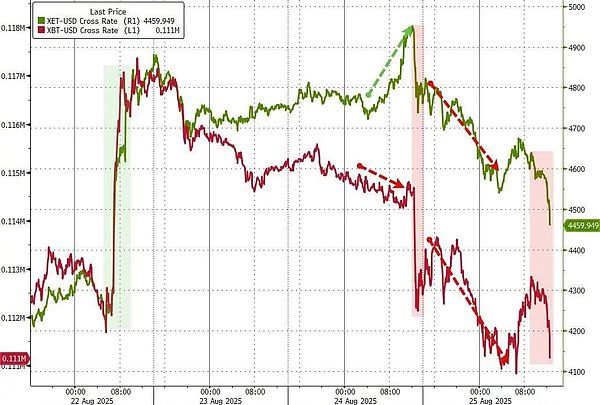
In the past 48 hours, the two major cryptocurrencies in the world have experienced extreme market volatility.
Bitcoin suffered a “flash crash” after hitting a new high on Sunday, while Ethereum also took a sharp turn for the worse after hitting a record high. What exactly happened behind the “shocking shock” of the two major cryptocurrencies?
It is reported that this round of violent volatility in the cryptocurrency market has been caused by a series of chain reactions:Federal Reserve Chairman Powell at Jackson HoleDove statements at the Economic Policy Seminar, first pushing BitcoinAfter soaring to nearly $117,200 on Friday, Ethereum hit a new high, it climbed further on Sunday, setting a record high of $4,954.
But a giant Bitcoin whale that had held the currency for more than 5 years suddenly sold 24,000 Bitcoins, triggering a series of stampedes.
Bitcoin fell further to around $110,500 on Monday, andFor the first time since April, it fell below the 100-day moving average,Ethereum plunges from all-time highs to $4,400,andThe sudden sale of giant whale caused more than $570 million in Bitcoin and Ethereum (approximatelyRMB 4.082 billion) Forced closing position.

Analysts pointed out thatThe core of market turmoil is a huge reconfiguration of funds, with signs that this part of the funds are flowing to Ethereum, with about $2 billion of Bitcoin funds being reconfigured to Ethereum.
In addition, there are rumors that in this round of market turmoil, institutional investors BlackRock and high-frequency trading giant Jane Street are buying on dips, while ETFs such as Fidelity have recorded large capital inflows.Operations of market makers such as Jane Street are also believed to have exacerbated market volatility.
However, LMAX Group market strategist Joel Kruger said that despite the short-term pullback, institutional beliefs remain firm.
The “Two Cities” on the weekend: The new high and the flash crash coexist
Bitcoin and Ethereum have performed completely different market trends in the past 48 hours.
Fed Chairman Powell’s speech at Jackson Hall Economic Policy Seminar on Friday opened the door to a possible rate cut, driving a sharp rise in cryptocurrency prices.
Bitcoin soared from about $112,000 to nearly $117,200, after Ethereum rose sharply on Friday.It climbed further Sunday, hitting an all-time high of $4,954, surpassing the previous peak of about $4,891 in November 2021.
LMAX Group Marketing Strategist Joel Kruger said:
“Powell’s rate cut suggests that initially boosted sentiment, but the nuances of its wording and its inadequate dovish tone made the market uneasy.”
In addition, the reversal of the cryptocurrency rise is also behind the giant whale’s selling.According to CoinDesk, a Bitcoin coinThe giant whale sold 24,000 bitcoins and triggered a “flash crash”.The move triggered a chain reaction during weekends with thin liquidity.
This caused the price of Bitcoin to fall by more than 2% in 10 minutes, reaching a minimum of $110,500.By Monday afternoon, Bitcoin further fell to around $110,500, with the gains since 2025 narrowing to about 18%.

Jacob King of WhaleWire pointed out that the giant whale’s actions triggered panic selling from other traders, exacerbating the decline spiral.This liquidity tightening worsened against the backdrop of increased leveraged long positions in the previous week.
Compared with Bitcoin, although Ethereum also pulled back to $4,400, the year-on-year increase still exceeds 31%, which is significantly stronger than Bitcoin.
Giant Whale “Switch”: A strategic transfer of $2 billion
The core of this round of market turmoil is a huge relocation of funds.
According to the analysis on the linkThe giant whale account that sold 24,000 bitcoins still holds 152,874 bitcoins, worth more than $17 billion, and the investor holds these bitcoins for more than five years.
What is more important is the flow of funds.Data shows that after the Bitcoin sell-off, a considerable amount of funds were reinvested into Ethereum.Two entities reconfigure $2 billion worth of Bitcoin funds to Ethereum,Of these, 275,500 Ethereum (worth $1.3 billion) have been pledged.
Analysts believe that this capital reconfiguration reflects a broader shift in market sentiment, and investors are more optimistic about Ethereum’s growing utility in stablecoins, tokenization and smart contracts.
Jeff Mei of BTSE and Samir Kerbage of Hashdex pointed out that Ethereum’s smaller market capitalization may have a more obvious response to the potential Fed rate cuts and increased system liquidity than Bitcoin.
According to CoinGlass data,Bitcoin positions were forced to close $277 million in the past 24 hours, and Ethereum positions were closed $293 million.,Total $570 million, a total ofThe overall cryptocurrency clearing amount reached US$878 million.

Rumor of “buying at the bottom” on Wall Street: Institutional funds are in reverse layout
Amid the violent market fluctuations, rumors show that Wall Street institutions are taking the opportunity to buy at the bottom.
Financial blog zerohedge posted on social platform X,Fidelity, Bitwise, 21Shares and other institutions have seen significant capital inflows, the market is closely monitoring the trends of large asset management companies such as BlackRock.

According to rumors,Fidelity has achieved a net inflow of $87 million, Bitwise has flowed in $9.7 million, and 21 Shares has flowed in $5.6 million, and the market is still waiting for BlackRock’s latest trends.Although not officially confirmed, these data reflect that institutional investors may be taking advantage of market pullback opportunities to increase their holdings of cryptocurrency assets.
Another rumor that has attracted attention involves the operation of market maker Jane Street.It is reported that the company’s “momentum deception” operation caused Ethereum to fall into corrections within less than 24 hours after hitting a record high, and was described as one of the “most cruel” operations in history.
However, the overall capital flow of ETFs is differentiated.According to Farside Investors data, spot Bitcoin ETFs have recorded net outflows for six consecutive trading days as of last Friday, totaling US$1.19 billion.
Spot Ethereum ETF had net outflows of $925.7 million for four consecutive trading days, but recorded net inflows of $625.3 million on Thursday and Friday.
Despite the sharp short-term volatility, analysts remain cautiously optimistic about the medium- and long-term outlook.”As long as Bitcoin remains above $110,000 on the weekly closing basis, the market is expected to maintain good resilience in the decline,” said Kruger of LMAX.
Alex Krüger of Aike Capital pointed out that once short-term volatility subsides and prices break through the key resistance level of $113,500-114,000, Bitcoin may regain momentum.
Options data also show continued bullish sentiment.Sean Dawson of on-chain options platform Derive said the market has not been shaken by the pullback and the fundamentals remain intact.The current 7-day relative strength index (RSI) shows oversold status, but there is no clear reversal signal yet.







